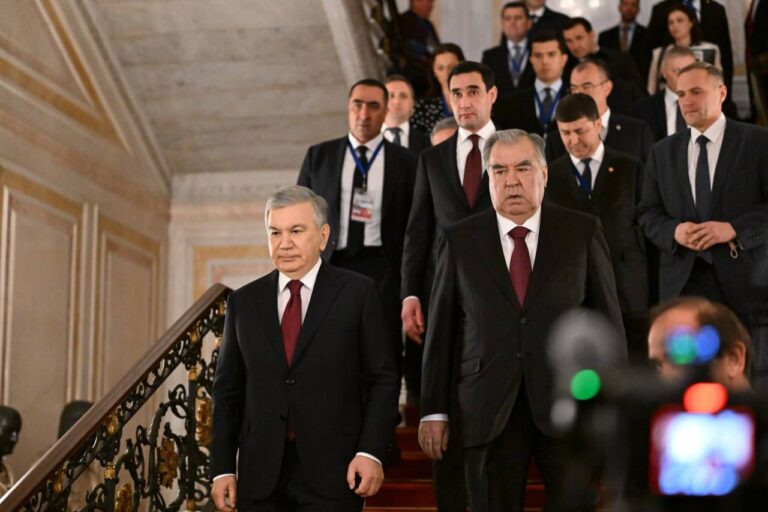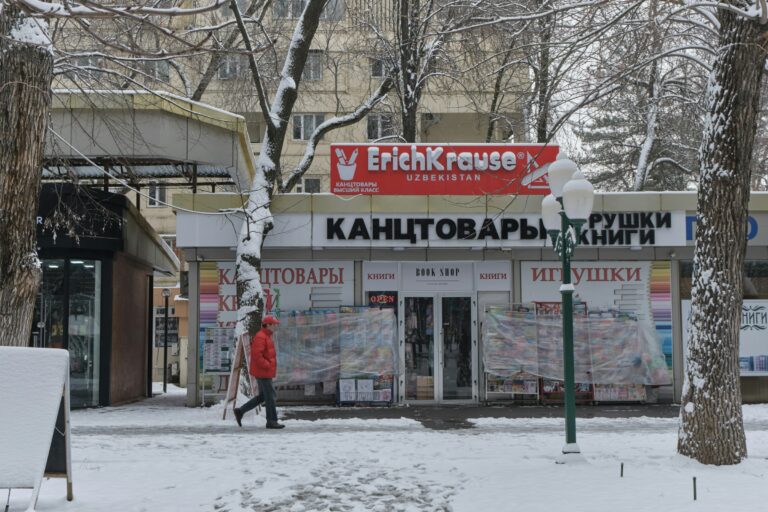The flow of religious tourists who want to visit holy places has been rising in recent years. The Kursiv edition tries to describe how religious tourism is developing and what Uzbekistan can offer to pilgrims.
Visas for Believers
Since 2018 the number of tourists from various Muslim countries has been constantly growing, according to the Ministry of Tourism and Sport of the Republic of Uzbekistan. For example, the quantity of guests from Indonesia has risen by 70%, from Malaysia by 58%, from Turkey by 54% and from the UAE by 53%.
Evolving visa regulations play a key role in this process. In 2018 Uzbekistan simplified its visa receiving process for religious tourists or pilgrims. Next year, the country also introduced a two-month pilgrim visa for those interested in Uzbekistan’s cultural, historical and religious heritage. As the State Committee on Tourism estimates, one foreign tourist spends about $160 on an average trip (the flight tickets are excluded). In general, the main expenditures are accommodation, transportation and meals.
Before the pandemic, foreign pilgrims accounted for 7% of the total number of foreign tourists in Uzbekistan, according to Saidakhmad Raubayev, head of the Yasmina Tour company. However, the number of local tourists and pilgrims is also increasing, he noted.
Infrastructure for Pilgrims
In February 2019 the so-called Bukhara Declaration was signed. The document recognizes Uzbekistan as one of the world’s centers of religious tourism. Later, the same was done by the Global Muslim Travel Index, which put the country in a list of the ten most attractive member states of the Organization of Islam Cooperation.
However, in terms of comfort for tourists, Uzbekistan is just at the 18th position of that rating, which is not bad though. For example, Kazakhstan and Azerbaijan have taken 19th and 20th places respectively.
Uzbekistan’s authorities and businesses consider religious tourism as one of their top priorities. Many new hotels are being constructed with pilgrims in mind. For instance, two new hotels near complexes of imam al-Bukhari in Samarkand and Baha-ud-Din Naqshband in Bukhara, which are currently under construction, were in line with new standards already at the designing stage. For example, both hotels are close to mosques; rooms in the hotels are equipped with Qibla direction signs and baths for ablution.
Nevertheless, many other regular hotels are trying to supply needs from the growing sector of religious tourism. According to the head of marketing in Hyatt Regency Tashkent Anna Martusevish, even though the core audience for the hotel is business tourists, its rooms are also equipped with Qibla direction signs. If a guest needs a prayer rug, he or she can request the administration. Moreover, over Ramadan fasting any believer can have their iftar in the hotel’s restaurant.

Travel with a Discount
To accelerate the development of ziyerat-tourism, Uzbekistan has to make air travel more affordable. Current prices for air travel are too high and this factor affects the entire industry of religious tourism, according to Farkhod Khoshimov, head of the Real Dreams tourist firm from Tashkent.
The government is going to solve this problem by providing airlines with discounts. The plan is to attract as many air companies as possible. Those companies engaged in religious tours can get a 50% discount for ground services in airports all over the country. Moreover, all these gateways are part of the Open Sky regime.
Before the pandemic, there were regular flights to Mekka, Medina in Saudi Arabia and many other centers of Muslim culture. Now, this air travel is gradually recovering. For example, Uzbek authorities want to open regular air travel with Pakistan. To achieve that goal, Uzbekistan signed an agreement with two low-cost airlines: Air Arabia and Fly Egypt. In addition, since March 1, the ten days visa-free regime has been working for citizens of Bahrain, Qatar, Kuwait, Oman and PCR.
Focus on Neighbors
Uzbekistan pays particular attention to pilgrims from other Central Asian states. In the interview with Kazakhstani TV channel Khabar 24, Vice Minister, Minister of Tourism and Sport of the Republic of Uzbekistan Aziz Abdukhakimov said that Uzbekistan and Kazakhstan are going to launch combined tours for those who want to visit popular holy sites in both countries.
First of all, Uzbek and Kazakh authorities plan to simplify border-crossing rules. For example, they have created a unified visa regime to make it easier to visit each other.
As Saidakhmad Raubayev noted, there are lots of sites in Uzbekistan in which Kazakh tourists can be interested.
«These kinds of tours may be designed in a special way to let people visit historical sites, which are associated with several Kazakh religious figures. It might be a tour to mausoleums of two prominent Kazakh leaders of the past, Tole Bi and Ayteke Bi in Tashkent and Navoi respectively. They are both well known as authors of the set of laws called Zheti Zhargy,» he said.
Kazakhstani tourists can also be interested in combined tours to sites where some Sufism leaders lived. Such a tour may be started in Turkestan, where the mausoleum of Sufi poet Akhmed Yassavi is located. Then tourists can go to Zangiata mausoleum (a pupil of Yassavi) and then to Khakimota Bakirgoniy in Karakalpakstan. The price for this five-day-long trip in a group of ten people would start from $200 per one tourist.
Kazakhs Should See It
According to Lazzat Akhanova, the honored ambassador of the tourist brand Uzbekistan in the Republic of Kazakhstan, travelers from Kazakhstan might be interested in tours to Khiva. From the beginning of the 19th century, Khorezm was ruled by the Konyrat dynasty, which is part of the Kazakh family of Konyrat. She also advises Kazakhstanis to visit the Navoiy region.
«Uzbekistan did a lot to preserve and bring to an excellent condition all those historical sights related to the past of the Kazakh people. Modern infrastructure was built there, and high-quality services, including guides, are now available. For Kazakhstanis, the most attractive site in Navoiy, of course, is the mausoleum of Ayteke-bi, a representative of the Younger Zhuz, a great figure who had a great influence on the unification of the Kazakh people. Another attraction, the Chashma complex, is also located nearby.
This is one of the main religious and tourist sites for Kazakhstanis and Uzbekistanis. According to legend, this a place where Nuri-ata, a companion of the Prophet Muhammad, and several of his followers were buried. So, due to closed borders amidst the pandemic, Uzbekistan is becoming an interesting destination for tourists and businesses that work in this area,» Akhanova said.
In December last year, travel companies in the Navoiy region of Uzbekistan and Kazakhstan agreed to cooperate in developing pilgrim tourism to increase the flow of travelers to the region. There are many things to do in the Navoiy region, including excursions and gastronomic, mountain and health tours. The latter kind of tours enjoys particular success among residents of the southern regions of Kazakhstan, according to Farhod Khoshimov.
Uzbekistan also participates in the formation of the Unified Calendar of Cultural Events for member states of the Turkic Council. Currently, Tashkent and Nur-Sultan are discussing the possibility of introducing the SilkVisa (the Central Asian version of the Schengen visa) to attract more foreign tourists to the countries of Central Asia. It is expected that some other countries of the region plus Azerbaijan would join this visa project.
In the middle of the Silk Road
In terms of religious tourism, Uzbekistan is unique thanks to its geographical location. The country is located in the center of the Great Silk Road where different cultures, civilizations, and religions have met. There are lots of unique monuments of oriental architecture as well as Islamic, Christian and Buddhist holy sites because Christianity and Buddhism were widespread in the region long before the arrival of Islam.
The most famous of them are the mausoleums of Imam al-Bukhari and Imam at-Termizi. They were authors of hadiths collections and are still venerated in the Muslim world. Moreover, Bukhara is a place where the tomb of the founder of the Sufi order Bahauddin Naqshbandi is located. The Hast-Imam ensemble in Tashkent and the Muyi Muborak madrasah (16th century), where the hair of the Prophet Muhammad is kept, are also world-famous pilgrimage sites.
The museum of the Muslim Board of Uzbekistan houses the only original version of the Quran owned by Qaliph Osman of the 7th century, which Muslims from all over the world come to see.
Both Muslims and Christians venerate the spring of the prophet Ayub (who is identified as Job from the Bible) in Bukhara and the mausoleum of Khoja Doniyor near Samarkand. (It is believed that the ashes of the biblical prophet Daniel are buried here.) A point of attraction for Christian pilgrims from the CIS countries is the Cathedral of Assumption in Tashkent. It is the oldest cathedral in Central Asia built in 1871.
Among the Buddhist monuments in Uzbekistan are the oldest Buddhist temple complexes on the territory of Old Termez in the Surkhandarya Region: Fayaztepa (dates back to the 1st to 3rd centuries BC), Kampirtepa and Karatepa. These monuments are already a place of pilgrimage for tourists from Japan, South Korea and other Asian countries where Buddhism is practiced.
On top of that, Uzbekistan is going to introduce new sites of attention to foreign pilgrims. The republic is developing the concept of creating a memorial complex of Imam Moturidi (a world-famous scientist-theologian) in Samarkand, a major center of pilgrimage. Also, it is planned to build a museum of Islamic history in Bukhara. The largest Islamic Civilization Center in the region is already being built in Tashkent. It is planned to invite well-known scientists in the Islamic world to work in the center; in the future, the Center for Islamic Civilization should become one of the leading research institutes for the study of Muslim heritage throughout the world. The complex is being built in the national style of architecture and includes a mosque, a library, an information resource center, scientific departments and conference halls.













